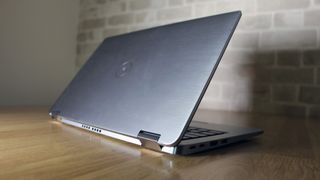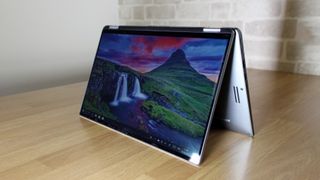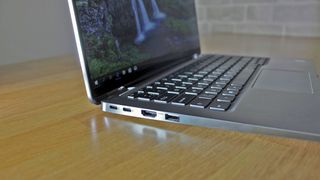IT Pro Verdict
The screen and CPU don’t fulfil their potential here, but in every other department the Latitude is deeply impressive – which makes it a worthwhile option for versatile, stylish working
Pros
- +
Screen has fantastic colour and contrast
- +
Excellent convertible design
- +
Good port versatility
- +
Internal access available
Cons
- -
CPU could be faster
- -
Screen isn’t bright enough









The latest Dell Latitude doesn't look like a Dell Latitude. It's a far more stylish machine than we're used to seeing from this well-established range of business devices, so it'll look at home on the sofa as well as in the boardroom.
Latitude machines can't just look good, though - they have a job to do. And, with a price of 1,639 exc VAT, this machine commands a healthy premium over rivals. Can the latest Dell prove that it's got both form and function?
Dell Latitude 7400 2-in-1 review: Design
The Latitude is made from aluminium, with a dark, brushed design used across most of the surfaces and a glossier finish on the hinge and the precision-milled edges. Throw in the small Dell logo on the lid, the slim screen bezels and the sunken keyboard and you've got a machine that can stand toe-to-toe with the best-looking laptops, like Apple's MacBook Pro and Dell's own XPS 13.
Build quality is superb: there's barely any give in the metal around the keyboard, and the screen is rigid. The drop hinge is rock-solid, and the screen rotates with a satisfying, smooth action. It's not quite possible to open the machine with one fingertip - the base pitches upwards - but that's a tiny complaint. Overall, the build is just as good as the XPS 13 and only a little short of the class-leading MacBook. The only slight worry is the underside; the metal can be pushed a couple of millimetres down, touching the components inside.
It's no surprise that the Latitude matches its rivals for design - the equivalent XPS only costs 1,149 exc VAT, and a similar MacBook is 1,475 exc VAT. The Latitude is pricier than both.
Most ultraportable hybrids don't allow full internal access, but the Latitude does. Ten standard Phillips screws secure the base, and handy indents behind each hinge allow the panel to ease free. Most components can be accessed, but there's no spare upgrade room and the memory is soldered down.

Dell's machine weighs 1.3kg and is 14.9mm thick, which is impressive for a convertible. However, its rivals - which are conventional laptops - aren't much different. The Dell XPS 13 is 11.6mm thick and weighs 1.23kg, while the MacBook Pro arrives at 14.9mm and 1.37kg.
The Dell flexes its business credentials with good connectivity. On the left-hand side you get two Thunderbolt 3 ports that handle DisplayPort and charging, alongside a power-delivering USB 3.1 socket and an HDMI output. The right-hand side has another full-size USB port, a microSD slot, a SIM card tray, an audio jack and a Kensington slot.
The Latitude's webcam has the Dell ExpressSign-In feature. It combines the webcam's facial recognition abilities with the machine's proximity sensors to automatically lock the laptop when you leave and unlock it when you return. It worked well in our tests. However, there are some things missing from the slimline Latitude - most notably a Gigabit Ethernet port. There's also no fingerprint reader in the power button - unless you're willing to pay extra. On the inside, connectivity is covered by dual-band 802.11ac wireless and Bluetooth 5.0.
Dell Latitude 7400 2-in-1 review: Keyboard & Trackpad
The Dell's keyboard and trackpad are both fine, but neither are excellent. The keyboard has no numberpad, but its layout is sensible: you get a double-height Return key, sizeable cursor keys and sensible options on the Function row. The buttons are fine for general-purpose typing. They're fast and comfortable, with good speed and snap and without requiring a huge amount of force to push. They're quiet, and the base is firm. It also helps that the top of each button is slightly concave.
However, the buttons are not without issue. They're not particularly big, and their edges are slightly curved - which means that each key feels slightly too small. Many users will get used to the compact buttons, but typists with larger fingertips may not be entirely comfortable on the Latitude. The backlight isn't great, either. It's only got two brightness levels, and the lighting isn't very consistent, with uneven lighting visible around the keys.

The glass touchpad is large and smooth, with good precision and a satisfying clicking action, but it doesn't have discrete buttons - they're built in to the bottom of the pad. The buttons are fine, but they do push down a little too far - so the milled edge of the pad can dig into fingertips slightly.
Dell Latitude 7400 2-in-1 review: Display
Dell has crammed a 14in IPS screen into the Latitude's 13in chassis. That design decision, and the inclusion of a drop hinge, means that the panel has four impressively slim bezels. It's a 10-point multitouch screen with Gorilla Glass 5 that works with Dell's active stylus pens - although they're sold separately.
The panel has a 1080p resolution, which means a density level of 157ppi. That's fine for day-to-day work, although it doesn't offer the sharpness of the MacBook's 2,560 x 1,600 screen. There are no 4K options available, but that would add cost, reduce battery life and give few discernable benefits, so it's no great loss.
The Dell delivers fantastic colour quality. The average Delta E of 0.8 is stunning - as impressive as many professional displays and at 2.44, the maximum Delta E is barely beyond the point where human eyes can detect deviation, and only achieved in one test. In short, Colours on this panel have near-perfect accuracy.
The colour temperature of 6,196K is fine: a tiny bit warm, but not far enough from 6,500K to make the screen look inaccurate. The Dell rendered a stonking 99.5% of the sRGB colour gamut, and 70.6% of the Adobe RGB gamut. That's fine for a laptop that isn't designed for photo and design work, and it means that the Latitude's panel will display any shade you'll conceivably need.
The contrast level of 1,775:1 is fantastic, too - one of the best results we've seen, and bolstered by a superb black point of 0.12cd/m2. The Dell delivers incredibly deep black shades, vibrancy with every colour, clear, bright shades at the top of the range and subtle variations in between. More impressively, the Latitude has better Delta E and sRGB levels than even the XPS 13, and better contrast than the MacBook.

That's all great, but the Dell does have one major issue: brightness. The panel's peak brightness of 213cd/m2 is low. It's not a problem in an office, where that's enough backlight strength to keep the screen visible. But try to use the Dell outdoors and it's just not strong enough - especially when combined with the panel's glossy finish.
Dell Latitude 7400 2-in-1 review: Hardware & Performance
This entry-level Latitude is powered by a Core i5-8265U processor. It's a popular chip that comes from Intel's new Whisky Lake-U range. It's got four cores with Hyper-Threading, but it's a low-power CPU, which means a modest base clock speed of 1.6GHz and an all- and single-core Turbo peaks of 3.7GHz and 3.9GHz. The huge disparity between those speeds is due to a new Intel feature called Thermal Velocity Boost, which adds even more headroom to the CPU's existing Turbo Boost abilities based on the chip's thermal headroom. It's designed to make the chip more reactive - and, therefore, make laptops more responsive.
The CPU is paired with 8GB of LPDDR3 memory. That's the bare minimum we'd expect for day-to-day workloads, but we're glad it's installed in dual-channel configuration. Elsewhere, there's a 256GB Toshiba SSD and Intel's integrated GPU, with no room for discrete graphics - so the Latitude will only handle very basic photo work. You also get TPM 2.0. It's a fine specification for general work, but it's unable to square up to either the XPS 13 or the MacBook thanks to an overall benchmark score of 89.
The Dell XPS 13 and Apple MacBook Pro that we reviewed both included last-generation, low-power Core i7 chips that aren't too much different from the Latitude's CPU - they still have the same core count and only marginally better speeds. Despite that, the XPS 13 and MacBook scored 96 and 150 respectively. The XPS has also now been updated with its own Whisky Lake-U CPUs.
The Latitude's lower score is caused by thermal issues. We ran the tricky Cinebench benchmark and the processor quickly throttled, with all of its cores dropping to around 2.5GHz - and sometimes lower. That's a long way short of the chip's all-core Turbo peak of 3.7GHz, and it's going to have a significant impact on performance in difficult, sustained CPU-intensive tasks.
In a CPU stress-test, with all cores running at 100% load and the machine in its default Optimized mode, the CPU throttled to 2.2GHz while the temperature rocketed to 93C. The machine automatically switched to its Cool mode, which dropped the clock speed to around 1.9GHz and reduced the temperature to 89C. Manually activating Dell's Ultra Performance mode saw the speed recover to 2.1GHz. In the CPU stress-test the Latitude was usually silent and only produced a tiny bit of fan noise in Ultra Performance mode - all easily manageable. The base became warm, but it was never too hot.

Running a full-system stress-test caused more issues. In the Latitude's Optimized mode, the temperature returned to 93C and the CPU ran at around 1.7GHz, with that speed maintained in Ultra Performance mode - although some fan speed increases saw the temperature drop to a more manageable 84C. Happily, the fan noise remained modest. The full-system test saw the outside become too hot, particularly on the left-hand side of the keyboard and base. A few minutes of use on a lap and it'll become uncomfortable.
It doesn't depend which performance mode if you use, or if you're pushing the CPU alone or working with the GPU, too: if you try to do anything intensive here, you won't get the CPU's full power. The MacBook Pro, in particular, does a better job of exploiting its full CPU abilities, which makes it a better option for tougher work.
Dell has fitted the Latitude with a 52Wh battery - the same size as the XPS 13, and a little behind the MacBook. However, the 1080p screen and the new CPU's more aggressive power management helped the Latitude deliver better longevity than either rival. In our test the Dell lasted for 16hrs 9mins - way beyond the ten hours of the XPS and the eight-hour lifespan of the MacBook.
This excellent result means the Latitude will easily make it through a day of work - and the commute home. However, be aware that having a Core i7 CPU, using tougher software or running the screen at higher brightness will reduce that lifespan. So will having the Latitude run lots of networking tasks - our benchmark uses flight mode.
Dell Latitude 7400 2-in-1 review: Different Models
This Latitude is the cheapest model available, with a cost of 1,639 exc VAT. Every Latitude uses a Core i5 or Core i7 processor and an NVMe SSD, with no secondary hard disk options available - great for speed, but less handy if you need space to store loads of files.If you like the model we've reviewed but want Intel vPro too, then it's possible to spend 20 exc VAT more to fit the relevant CPU. The next step up doubles the SSD space to 512GB and costs 1,729 exc VAT. A version at 1,749 exc VAT retains the 256GB SSD but doubles the memory to 16GB. The most expensive Latitude costs 1,949, and it's the only model available with a Core i7 CPU. It has the 256GB SSD alongside 16GB of memory and vPro.

The Latitude's core components can't be altered, but other areas of the specification can be augmented. If you want mobile broadband it'll cost an extra 138 exc VAT, and adding the fingerprint reader is 22 exc VAT. Adding NFC brings that figure to 29 exc VAT, and smart card readers can also be added. They're good options, but it's especially galling that the fingerprint reader is an additional cost - those are common features in high-end business laptops now, and most rivals won't charge extra.
Dell Latitude 7400 2-in-1 review: Verdict
The latest Dell takes an old business name and brings it right up to date. This new machine looks fantastic - easily attractive enough to stand alongside the best consumer and corporate devices - and it's slim and sturdy, with a good convertible mechanism.
It's more practical than the XPS 13 and MacBook. It has that convertible operation, and it has better connectivity alongside easy internal access. The battery is superb too - better than either competitor. On the inside, the screen has fantastic colours and contrast, even if it's not bright enough for outdoor use. And the components are good enough for mainstream work, although thermal issues prevent them from hitting their full potential.
The underwhelming CPU performance, the dim screen and the middling keyboard and trackpad mean that the Latitude isn't ideal for tougher work. If that's what you're after, the MacBook Pro is better. However, if you want a daily driver with a great touchscreen, loads of versatility and convertible operation, this is excellent.
Mike Jennings has worked as a technology journalist for more than a decade and has been fascinated by computers since childhood, when he spent far too long building terrible websites. He loves desktop PCs, components, laptops and anything to do with the latest hardware.
Mike worked as a staff writer at PC Pro magazine in London for seven years, and during that time wrote for a variety of other tech titles, including Custom PC, Micro Mart and Computer Shopper. Since 2013, he’s been a freelance tech writer, and writes regularly for titles like Wired, TechRadar, Stuff, TechSpot, IT Pro, TrustedReviews and TechAdvisor. He still loves tech and covers everything from the latest business hardware and software to high-end gaming gear, and you’ll find him on plenty of sites writing reviews, features and guides on a vast range of topics.
You can email Mike at mike@mike-jennings.net, or find him on Twitter at @mikejjennings
